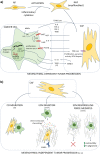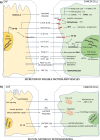Cancer-associated fibroblasts as abettors of tumor progression at the crossroads of EMT and therapy resistance
- PMID: 30927908
- PMCID: PMC6441236
- DOI: 10.1186/s12943-019-0994-2
Cancer-associated fibroblasts as abettors of tumor progression at the crossroads of EMT and therapy resistance
Abstract
In the last decades, the role of the microenvironment in tumor progression and therapeutic outcome has gained increasing attention. Cancer-associated fibroblasts (CAFs) have emerged as key players among stromal cells, owing to their abundance in most solid tumors and their diverse tumor-restraining/promoting roles. The interplay between tumor cells and neighboring CAFs takes place by both paracrine signals (cytokines, exosomes and metabolites) or by the multifaceted functions of the surrounding extracellular matrix. Here, we dissect the most recent identified mechanisms underlying CAF-mediated control of tumor progression and therapy resistance, which include induction of the epithelial-to-mesenchymal transition (EMT), activation of survival pathways or stemness-related programs and metabolic reprogramming in tumor cells. Importantly, the recently unveiled heterogeneity in CAFs claims tailored therapeutic efforts aimed at eradicating the specific subset facilitating tumor progression, therapy resistance and relapse. However, despite the large amount of pre-clinical data, much effort is still needed to translate CAF-directed anti-cancer strategies from the bench to the clinic.
Conflict of interest statement
Ethics approval and consent to participate
Not applicable.
Consent for publication
Not applicable.
Competing interests
The authors declare that they have no competing interests.
Publisher’s Note
Springer Nature remains neutral with regard to jurisdictional claims in published maps and institutional affiliations.
Figures


References
-
- Chen X, Song E. Turning foes to friends: targeting cancer-associated fibroblasts. Nat Rev Drug Discov. 2018. - PubMed
Publication types
MeSH terms
Substances
LinkOut - more resources
Full Text Sources
Other Literature Sources
Medical

